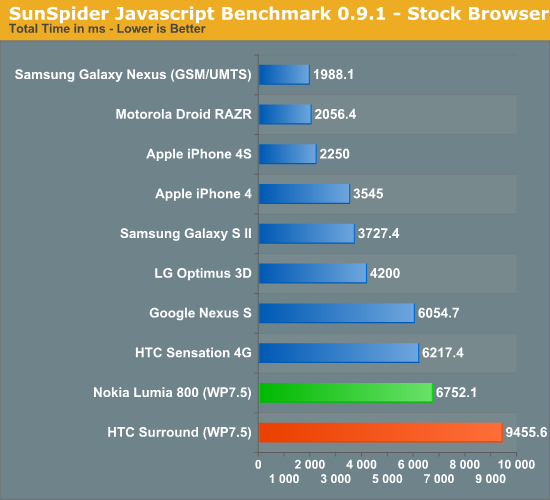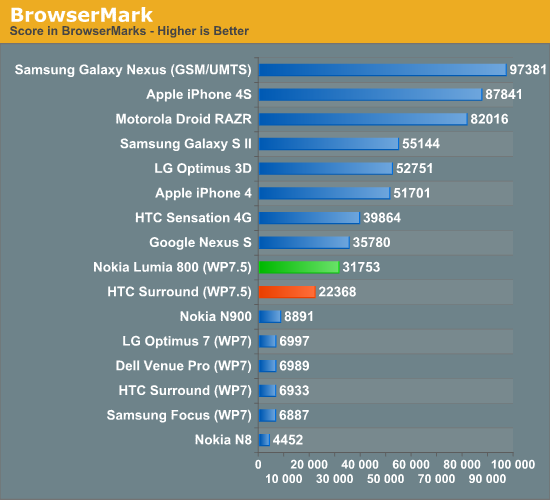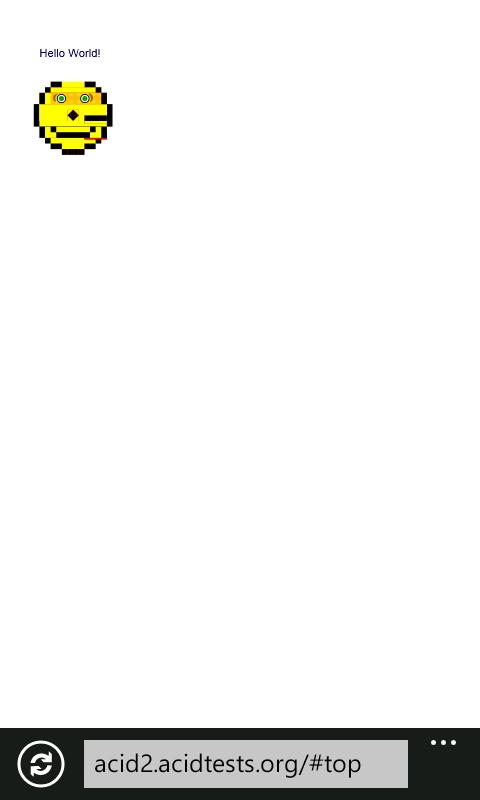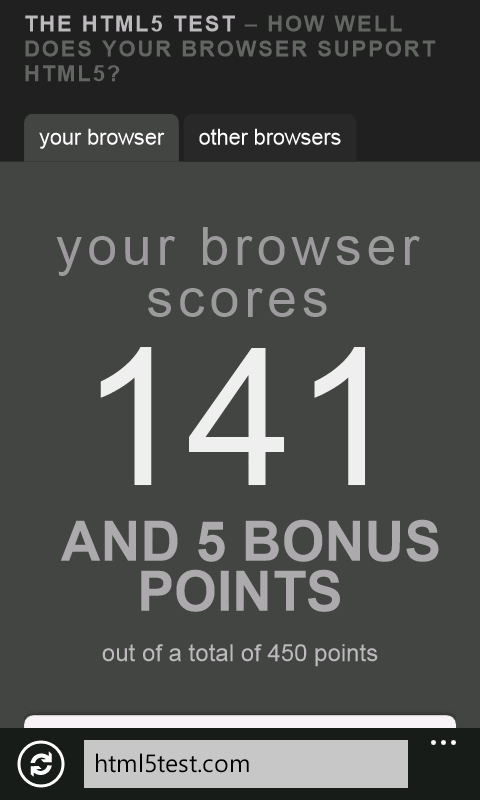Nokia Lumia 800 Review - Nokia's Brave New Foray into WP7
by Brian Klug on January 4, 2012 7:00 AM EST- Posted in
- Smartphones
- Nokia
- windows phone 7
- Mobile
- WP7
- Lumia
- Lumia 800
Unfortunately, the majority of benchmarks that usually grace our smartphone reviews don’t yet have WP7 ports or analogs, but there are a still a number of comparisons we can make. To start, the browser-based performance metrics give a good picture within the Windows Phone ecosystem, and likewise with WPbench, created by one of our own readers and on the marketplace.
There’s been a lot written about performance on WP7 already - namely that comparative analysis isn’t as big of a deal as it is on other smartphone platforms, but of course this is more the result of two things. First, Microsoft’s careful curation of their new smartphone platform with hardware requirements; second, availability of native and managed code execution environments. For the most part, you can pick up any WP7 device and have very good expectation of UI smoothness, but that’s not to say there aren’t differences, especially as the platform moves from one generation of Snapdragon SoC to the next, and now possibly even a move to ST-E. Benchmarking WP7 (and by analog, Windows 8) will become a big deal very soon, however, and numerous SoC vendors and big names in the PC benchmarking scene are looking to port to these platforms.
This current refresh of WP7 devices continues to be based around exclusively Qualcomm SoCs, and the Lumias are no exception. Both the 710 and 800 are based around Qualcomm’s MSM8255 single core S2 Snapdragon at 1.4 GHz with Adreno 205 graphics at the core and dual channel LPDDR2 memory interfaces. This is a 45nm part we’ve seen and explored numerous times before, and as a refresher includes the HSPA+ 14.4 baseband onboard.
Anyhow, onward to the numbers. First is sunspider, which we’ve been using for a long while and recently changed from 0.9 to 0.9.1 with. As a result, I’ve had to re-run devices since the numbers aren’t directly comparable. WP7.5 brings a much improved javascript engine which gives it a big boost in scores. I’ve managed to hang onto the HTC Surround (1.0 GHz QSD8250) and Anand has the Focus (also 1.0 GHz QSD8250), which we’ve included as well.

Browsermark hasn’t changed or forced us to re-run things, so we have comparison numbers that show how much difference there is in the browser department in WP7.5.

In the synthetics, WP7.5’s new JavaScript engine (Chakra) with JIT brings perf almost up to modern levels and is a step in the right direction, but it’s still behind iOS and Android. Moving to a higher clocked single core probably does make sense for Windows Phone, especially if IE is single threaded at this point.
For system benchmarking on WP7.5 we have WP Bench, which was created by one of our own readers. The benchmark reports a total score in addition to three sub-scores for CPU, memory, and GPU. My only point of comparison, again, is the HTC Surround.
| WPBench Comparison | ||
| HTC Surround (1.0 GHz QSD8250) | Nokia Lumia 800 (1.4 GHz MSM8255) | |
| Total Score | 59.85 | 91.14 |
| Result Screenshot |
|
|
Browser Performance and Changes
I’ve made a big deal about browsing performance because, for me at least, the stock browser is the one place where performance really must be flawless. OEMs are starting to wake up to the fact that browsing performance makes a huge impact on the overall subjective weighting of a platform’s smoothness, which in turn results in a lot of scrutiny. I’d agree with this assertion as well and toss in a few other things that must be flawless for a platform to feel speedy.
When WP7.5 first started surfacing we took a look at its revamped IE9-based browser which uses Trident 5.0 as opposed to NoDo’s Trident 3.1. Unsurprisingly everything we saw in the emulator applies to the real-world experience with WP7.5 on live devices. Actually things are even a bit better than they were when we played around in the emulator.


The Windows Phone team has made clear several times that they aren’t going to build the browser to any tests but instead real-world page rendering accuracy. That said it’s still worthwhile to take a look at the synthetics. Acid 3 now completes and nearly passes (the boxes in top right subtract some points) where it previously scored below 95. Similarly Acid 2 now is almost flawless. Finally, the HTML5test score increases from 130 to 141 on the Lumia 800 and newer WP7.5 builds, which is a slight but still important difference.

Moving away from Trident 3.1 to 5.0 has made a huge difference on faithful page rendering and eliminated nearly all of the annoying edge cases I saw with previous WP7 smartphones. A number of pages I visit daily back when we did those reviews would render but with a few notable errata, these are now gone completely.
In addition, scrolling performance remains just as speedy as it was before (essentially buttery smooth) as the rendering architecture remains largely the same. We now have all three platforms (WP7.5, iOS, and Android 3.x/4.x) rendering the browser page into a texture that can be translated, clipped, and zoomed with GPU operations. It’s clear that this is the right way to do things to keep the browser UI speedy.
The changes to WP7.5’s browser make (for me at least) the single most notable improvement over NoDo and previous iterations. It’s a huge step forwards in rendering, compliance, and UI, and having that browser experience be as close to perfect as possible is tremendously important.












120 Comments
View All Comments
Starfireaw11 - Wednesday, January 4, 2012 - link
For the most part, my Lumia 800 is fast, responsive and smooth. There are a few times where you do notice a bit of a slowdown, but certainly nothing worse than any other phone I've ever come across.A smartphone will always be a balancing act between power consumption, cost and performance, while maintaining a small form-factor. While a Xeon based smartphone would be possible, I don't see one being commercially successful for some reason :D
bplewis24 - Wednesday, January 4, 2012 - link
Android doesn't have bloated applications nor a bloated OS. Troll harder, or become informed as to what you actually speak of.N4g4rok - Wednesday, January 4, 2012 - link
My apologies, i should have specified.Over time, Android will slow down from fragmentation issues, like most OS's, but i've read more complaints recently about older versions of Android.
And unfortunately, due to poor coding, applications will occasionally succumb to memory leaks, further bogging down the OS. Of course killing the application will fix the problem.
It does not make Android inherently bad. It just makes the point that the OS would likely struggle on lower powered single core SoC's that some other phones have.
Penti - Wednesday, January 4, 2012 - link
Making core applications and libraries thread on a dual-core or quad-core SoC is just one way of speeding up some of the slower bits. But that's just a stop gap and just one way of doing it. You could just as easily do improvements for single-core SoC's there as well. Fragmentation actually helps overcome some of this. As the vendors put in improvements and eventually gets Google to redesign or implement new things. Just as you would get an actual NDK for WP at some point and can actually write and port normal applications to that platform. Which isn't trouble free. Which will hit limitations and which will fragment ones phone makers invest some into that platform. Nokia and ST-E will bring in none-Qualcomm hardware. They will bring in core alterations to the software and platform and eventually as it has already proven it will be hard to maintain everything.Just remember WP7 didn't even get sockets until Mango. Stuff like Spotify was ready for MeeGo at pretty much when Nokia released a device and released before Mango got it's client. Just because it got another model to paint stuff on the screen doesn't mean it is superior. Of course poor launchers can destroy a phone, but that is not where it's heading at with many of the vendors having already improved on that. Just look in another year and you will see a whole different market with dual-core being the standard platform driving WP. It took a year to even get basic applications on there... The development kit hasn't been proven as good as advertised by astroturfers. Nobody will make a business on a platform where you can sit and wait a year for even features 10 year old feature phones had.
N4g4rok - Wednesday, January 4, 2012 - link
I agree with that, and i do not mean to insist that WP7 is or will be superior to anything else.The options and large market share that Android offers makes it extremely attractive to multiple vendors, and on top of that, it's flexibility as a development platform is the icing on the cake. Combine that with Google's monitoring of software compatibilities and updating to suit, you end up with a solid, stable platform, just like their most recent releases are shaping up to be.
WP7 has neither of those qualities just yet. Although Microsoft may move in that direction with future releases,but they're taking their time to do it. Taking the time to ensure hardware compatibility is great, but like you mentioned, taking too long getting it up to speed will achieve nothing other than wasting a lot of time and money.
crispbp04 - Wednesday, January 4, 2012 - link
Look at the pot calling the kettle black.doubledeej - Thursday, January 5, 2012 - link
I've had two different top-of-the-line Android phones and they were both horribly slow and liked to stutter constantly. It was very annoying. I switched to WP7 and haven't looked back.steven75 - Wednesday, January 4, 2012 - link
"I've had the device for about a month now and I have to agree with everything that has been said in this article - I'm really happy with it and it's a huge improvement over the iOS,"Except the review doesn't say this. It basically points out that WP7 Mango is where iOS and Android were a year ago.
crispbp04 - Wednesday, January 4, 2012 - link
Weak editorial. I lol'd at "fledgling application ecosystem".Spivonious - Wednesday, January 4, 2012 - link
Yeah, aren't there like 200,000 apps now? All of the needed ones are there.I've been very impressed with WP7 Mango. The fact is that you don't need apps because lots of functionality is built in. People hub gets you Facebook, Twitter, LinkedIn, as well as standard contact info and links to send texts, IMs, emails, post on walls, etc. The Messaging hub combines texting, IM, and emails, grouped by the person you're conversing with. The Xbox hub places all of your games in one place. The Music+Video hub places all of your media and media-watching apps in one place. Bing Search combines web search, Sound Hound, Google Goggles, and Yelp.
And live tiles on the main screen let me see what I'm looking for without opening an app.
The strength of WP7 is the integration of services in one place. It's perfect for the average consumer.